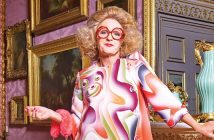“When shall we three meet again
In thunder, lightning, or in rain?
When the Hurlyburly’s done,
When the battle’s lost and won.
That will be ere the set of sun.”
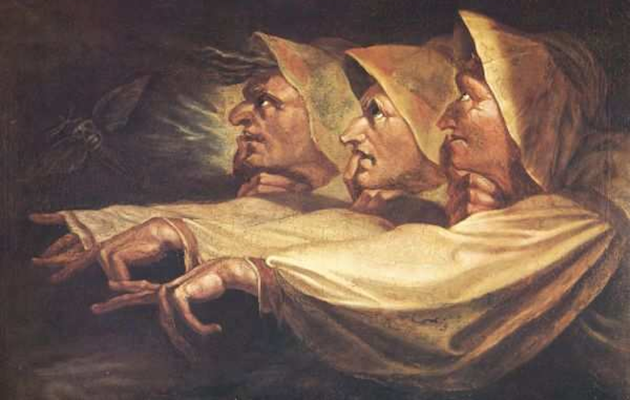
I could go on, at least until the end of the first page where my memory fails me. The lines are of course from the opening scene of Macbeth (or the “Scottish Play”, as it is sometimes referred to by board-treaders of a superstitious bent) and the speakers are the three witches, or weird sisters, of the piece. I studied the play for O-level and I can still recite the first page verbatim (and only this, possibly because my revision technique involved reading from the beginning each time my teenage mind foundered in distraction a short while later.) It remains one of my favourite Shakespeare plays, not only because it is such a brilliant depiction of human folly and greed, but because of the genuinely disquieting air of the supernatural that pervades. As everyone from Edmund Spencer, JRR Tolkein and JK Rowling could attest, weirdness and the supernatural sells.
The particular brand of weirdness that the Scottish National Gallery of Modern Art is selling this month and next (or perhaps more appropriately, “engaging the viewer with cultural dialogue”) is the witch. These maleficent termagants, present in most cultures across the world, have a particularly rich history in the Western canon, appearing as far back as the Witch of Endor in the Old Testament, through the sorceresses Medea and Circe in the narratives of Hesiod, Homer and Ovid, the enchantress Vivien in the Arthurian legends, right through to Milton and, of course, Shakespeare. The run continues with Goethe and spills across the artistic mediums, as demonstrated in this exhibition. In the twentieth century, cinema took the baton and so appeared the immortal Good Witch of the North and the not so immortal Wicked Witch of the West in “The Wizard of Oz”. In the “Blair Witch Project” it was left up to the viewer’s imagination to provide the thrills; the titular witch is never seen. It seems we all love a good witch, so to speak.
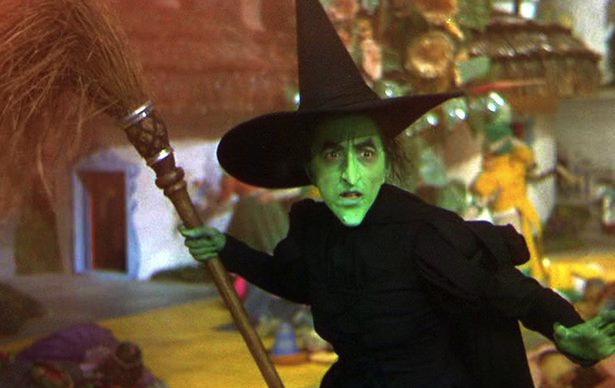
Fittingly, there is one whole room in the exhibition dedicated to visual depictions from Macbeth and the three weird sisters. Fittingly perhaps, too, is that the exhibition is held in Scotland, the setting of the play and home to so many malevolent bogeymen from the Kelpie and the Red Cap to the Alex Salmond. What excited me most though, was that it contained works by some of my favourite artists, including Dürer, Goya, Blake and Fuseli, the Swiss maestro of the macabre.
With such high anticipation it couldn’t fail to disappoint but, I confess, it did somewhat. This wasn’t the fault of the art which was uniformly of the highest order, but of the presentation. Most of the works on display were prints – etchings, engravings and woodcuts – or drawings combined with pen and ink wash and charcoal, and consequently quite small. These rely on detail so when one enters a room with dozens of these pictures to comprehend the effect is a trifle dismaying. Many of these images would have been reproduced in folios and manuscripts and this would have been the way to behold them – sitting down at a desk with a lamp overhead. Now perhaps this is an impractical suggestion but I do feel that many galleries are stuck in a nineteenth century approach to hanging. This works alright with large canvases but for small works such as these I think it fails the art.
Ditto regarding the superfluity of expositionary text on offer. It is meant to give context but I found it dulled one’s senses and distracted from the art. Surely there are other means by which information can be conveyed, and I suppose the audio guide is one (although I saw no evidence of them here.)
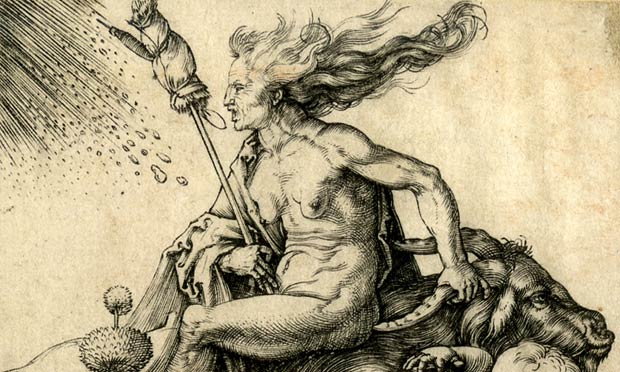
Detail from Albrecht Dürer, ‘Witch Riding Backwards on a Goat’ (1500)
But what of the art itself? Firstly, I find that a print or drawing evokes a different response from that of a painting; less emotional, more aesthetic and intellectual. One tends to look more with the head than with the heart. The exhibition is spread throughout half a dozen rooms, each of which seeks to examine a particular aspect of ‘witchery’, from “Unnatural Acts of Flying” to “Witches’ Sabbaths and Devilish Rituals” to contemporary representations in “The Persistence of Witches”. What was surprising, given that some of these works date from the late Middle Ages, was how familiar many of the tropes were. The witch as hideous hag with hanging dugs is all present and correct in Dürer’s “Witch Riding Backwards on a Goat” (1500) and Agostino Veneziano’s “The Witches’ Rout” (c.1520), just as it is in Cindy Sherman’s contemporary self-portrait made five hundred years later. Likewise, the image of the broomstick as magical flying apparatus is evident in Jan de Bisschop’s “A Witch Riding through the Air on a Dragon” (1643-71) (the monster entwined with the domestic implement), Goya’s “Linda maestra!” (“Pretty Teacher!”) and Ernst Barlach’s “Flying Witch” (1922).
The influence of Bosch can be seen in Bruegel’s “St James and the Magician Hermogenes” (1565) with its riot of demons and hybrid abominations, whilst Dürer’s exquisite rendering of the line and careful cross-hatching continues amongst the Northern and Central European artists. Their creatures have an ugly but compelling realism to them whereas the Italians, born out of the Renaissance, tend towards the sensual and voluptuous in their depictions. Even with blackness of diabolism, the Italians can’t resist the temptation to beautify their pictures.
There are paintings too, some of them large. Salvator Rosa’s “Witches at their Incantations” (1646) is the most creepily fascinating, offering a sort of A to Z on witchcraft. In the middle of the canvas a bloated corpse hangs from a leafless tree whilst all around it witches – many of them naked – and their servants engage in all sorts of diabolical practices from manipulating a wax manikin, wringing out a human organ into a cauldron, to using a skeleton’s hand to write a document.
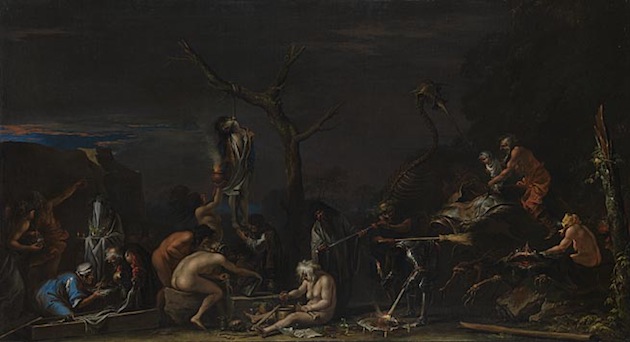
Salvator Rosa, ‘Witches at their Incantations’ (1646)
There is a fine Fuseli oil, too, taken from Shakespeare’s “Macbeth”, entitled “Macbeth, Banquo and the Witches”. Captured in his typical murky colours with a background that flickers away as if a void, the towering muscular figure of Macbeth, dressed in scale mail and with drawn bloody sword, stands at the far right. To the left, rising like eerie human notes, one atop the other, hover the three witches, their hands outstretched accusingly towards the future king and usurper.
In reality the various artists take the familiar elements of the witch and reflect them in the tastes, fashions, and sometimes politics of the time. Goya used the witch in his print series “Los Caprichos”, to satirise and express disgust at the excesses and repression by the clergy and ruling class.
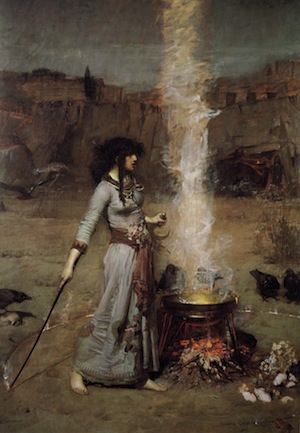
John William Waterhouse, ‘The Magic Circle’ (1886)
Conversely, the Pre-Raphaelite John William Waterhouse and Frederick Sandys depict their witches (“The Magic Circle” (1886), “Medea” (1866-8) and “Vivien” (1863) respectively) as raven-haired beauties who might easily be confused with society belles of the day. But even as far back as Dürer’s “The Four Witches” (1497) and Jost de Negker’s “The Temptation of St Anthony” (c.1500-20), the witch might as frequently appear as young seductress as warty old crone.
The pictures I saw were clearly works of the imagination; it is difficult to imagine anyone confusing them with reality. But the truth was, in the sixteenth and seventeenth centuries particularly, witch hunts were a reality across Europe. The victims were always women. (Women, considered the weaker sex, were thought to be more vulnerable to the solicitations of the Devil.) As I heard one young woman say as I was gazing at my umpteenth hag, “It’s like a history of misogyny.”
The supposedly dark arts hid a darker reality – that of prejudice, persecution and state-sanctioned murder. The monster which lurks in the collective subconscious became flesh and blood and victim to boot. There were those that spoke out against this preposterous unreason. The English gentleman Reginald Scot published his scepticism in “The Discoverie of Witchcraft” in 1584. But James I, a firm believer in witches and someone who considered himself to have fallen foul of a spell, had all the copies of the book confiscated and burned. What could one do when the king himself was leading the charge? It was a sobering thought and one which I carried away with the attractive exhibition publication – I’d rather my concept of the witch dwelt in the realm of the fantastical, of the outpourings of genius of Dürer, Goya, et al. There at least were villains I could trust.
“Witches & Wicked Bodies” runs at The Scottish National Gallery of Modern Art, Edinburgh, until 3rd November 2013. For more information visit the National Galleries’ Scotland website.

